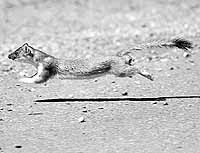| Several wildlife species in Utah have been classified as endangerd including the Utah prarie dog. Now is the time for Utah landowners to assist in the protection of these species by applying for a grant which will assist the owner in protecting and maintaining the endangered species natural habitat and environment. |
In an effort to get the public involved in the effort of conserving wildlife habitats, the U.S. Fish and Wildlife Service has announced that private landowners and wildlife agencies may apply for a grant to assist in this effort.
The USFWS announced that $50 million worth of grant money is available for landowners across the country. The funding is part of the Bush administration’s landowner incentive program and its private stewardship grants program.
“Private landowners and conservation groups want to help conserve fish and wildlife, but the costs of protecting, restoring and managing habitat can be prohibitive,” explained USFWS director Steve Williams. “The Bush administration is lending a hand to support the efforts of our valued partners.”
The landowner incentive program is a $40 million competitive grant program for state and territorial fish and wildlife agencies and tribes. The program supports collaborative efforts with private landowners interested in conserving natural habitat while they continue to engage in traditional land use practices.
The program also establishes or supplements existing landowner incentive programs that provide technical or financial assistance to private landowners for the protection, restoration and management of habitat to benefit species at risk, including federally listed endangered or threatened species, state sensitive species as well as proposed or candidate species on private land.
The private stewardship grant program provides $10 million in federal grants and other assistance on a competitive basis to individuals and groups engaged in voluntary conservation efforts on private lands that benefit at risk species.
In order to be eligible, projects must be voluntary conservation efforts carried out on private lands, including native lands.
| In order to apply for a national grant, landowners must submit a proposal explaining plans to protect endangered wildlife species such as the bald eagle. In order to qualify for grants, animals must be listed on the Utah state or national endangered species or sensitive species list. |
A minimum of 10 percent of the cost must be provided by non-federal sources.
In order to be considered for these funds, landowners must submit a proposal to the USFWS by Dec. 2.
As part of the effort, local Division of Wildlife Resource personnel have agreed to assist interested landowners in Carbon and Emery counties in constructing a proposal to be turned into the federal wildlife agency.
According to the USFWS, the majority of endangered and threatened species depend at least in part upon privately owned lands for their survival.
The help of landowners is essential for the conservation of these and other imperiled species.
Fortunately, many private landowners want to help. Often however, the costs associated with implementing conservation actions are greater than a landowner could undertake without financial assistance.
Those who are interested in sending a proposal for one of these grants may want to visit the DWR’s Internet website at www.wildlife.utah.gov where a list of endangered and state sensitive species is listed. By determining which animal can be assisted by a habitat improvement program, the landowner will have a general idea of what project can be managed with grant money.
Any interested landowners should contact Chris Colt at the local DWR office at 636-0260. Colt will be able to assist landowners with identifying ideas and writing proposals.
With $50 million dollars set aside to assist with improving wildlife habitats, it is important for local residents to participate by submitting proposals. After all, why not bring a sum of this money to Carbon or Emery County to improve the areas valuable wildlife.

